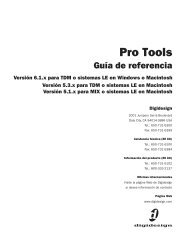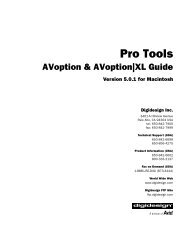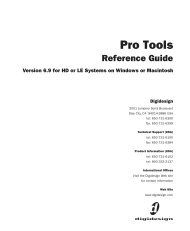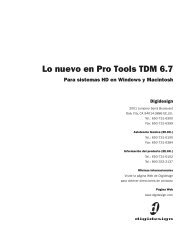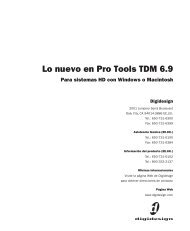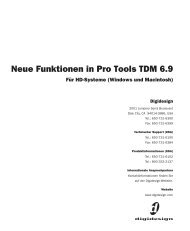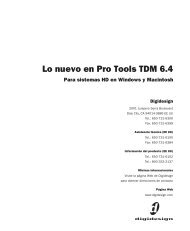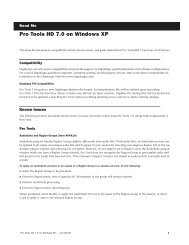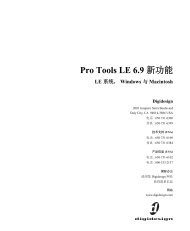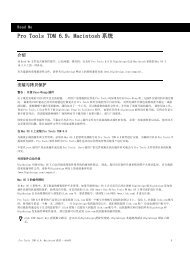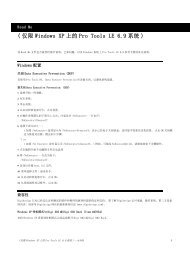5.1 DigiRack Plug-Ins Guide - Digidesign Support Archives
5.1 DigiRack Plug-Ins Guide - Digidesign Support Archives
5.1 DigiRack Plug-Ins Guide - Digidesign Support Archives
Create successful ePaper yourself
Turn your PDF publications into a flip-book with our unique Google optimized e-Paper software.
3 From the CPU Usage Limit pop-up, select the<br />
percentage of CPU power you want to dedicate<br />
to RTAS plug-ins and host processing.<br />
4 Click OK.<br />
For more information on the Hardware<br />
Buffer Size and CPU Usage Limit parameters,<br />
see the Pro Tools Reference <strong>Guide</strong>.<br />
Delay in Digital Signal<br />
Processing<br />
(TDM <strong>Plug</strong>-<strong>Ins</strong> Only)<br />
DSP processing in digital audio systems incurs<br />
signal delay of varying amounts. Such delays<br />
can vary from as short as several microseconds<br />
to as long as several milliseconds, depending on<br />
the type of processing applied.<br />
Delays are a matter of concern only if you use a<br />
real-time TDM plug-in on one channel of a<br />
multi-channel signal but not the others. This<br />
can cause the channels to be slightly out of<br />
phase.<br />
If you are working with mono tracks, or are processing<br />
all channels with the same plug-ins,<br />
these signal delays should not be a matter of<br />
concern.<br />
See Appendix B, “DSP Delays Incurred by<br />
TDM <strong>Plug</strong>-<strong>Ins</strong>” for information on delays<br />
inherent in specific <strong>DigiRack</strong> TDM plugins.<br />
See also the Pro Tools Reference <strong>Guide</strong><br />
for a guide to calculating DSP-induced delays.<br />
Compensating with TimeAdjuster<br />
You can compensate for TDM plug-in-induced<br />
delays by using the TimeAdjuster plug-in. This<br />
plug-in allows you to apply a specific number of<br />
samples of delay to the signal path of a Pro Tools<br />
track. TimeAdjuster provides settings files that<br />
apply the correct compensation time in samples<br />
for delay introduced by one or more plug-ins.<br />
See “TimeAdjuster” on page 39.<br />
<strong>Plug</strong>-<strong>Ins</strong> as <strong>Ins</strong>erts<br />
Real-time plug-ins are available as in-line inserts<br />
on audio tracks, auxiliary inputs, and master<br />
faders. A maximum of 5 real-time plug-ins can<br />
be used per track.<br />
When more than one insert is used on a track,<br />
they process the audio in series, each effect being<br />
added to the previous one, from top to bottom<br />
in the Mix window.<br />
If you are using both TDM and RTAS plugins<br />
on the same track, RTAS plug-ins must<br />
occur first in the signal chain, followed by<br />
TDM plug-ins. You cannot place TDM<br />
plug-in inserts before RTAS plug-in inserts.<br />
<strong>Ins</strong>erts can be used in two ways:<br />
On single tracks An insert can be applied to an<br />
individual audio track or auxiliary input using<br />
the <strong>Ins</strong>ert Selector on that track.<br />
With in-line inserts, you control the level of effect<br />
by adjusting the controls of the plug-in.<br />
As shared resources An insert can be used as a<br />
shared resource in a send-and-return arrangement<br />
by bussing signals from several tracks to<br />
an auxiliary input, and applying the insert to<br />
Chapter 2: Working with Real-Time <strong>Plug</strong>-<strong>Ins</strong> 5



